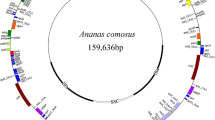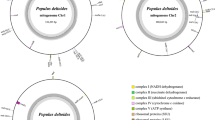Abstract
Polymorphic analyses of angiosperm mitochondrial DNA are rare in comparison with chloroplast DNA, because few target sequences in angiosperm mitochondrial DNA are known. Minisatellites, a tandem array of repeated sequences with a repeat unit of 10 to ~100 bp, are popular target sequences of animal mitochondria, but Beta vulgaris is the only known angiosperm species for which such an analysis has been conducted. From this lack of information, it was uncertain as to whether polymorphic minisatellites existed in other angiosperm species. Ten plant mitochondrial DNAs were found to contain minisatellite-like repeated sequences, most of which were located in intergenic regions but a few occurred in gene coding and intronic regions. Oryza and Brassica accessions were selected as models for the investigation of minisatellite polymorphism because substantial systematic information existed. PCR analysis of 42 Oryza accessions revealed length polymorphisms in four of the five minisatellites. The mitochondrial haplotypes of the 16 Oryza accessions with chromosomal complement (genome) types of CC, BBCC and CCDD were identical but were clearly distinguished from BB-genome accessions, a result consistent with the notion that the cytoplasmic donor parent of the amphidiploid species might be the CC-genome species. Twenty-nine accessions of six major cultivated species of Brassica were classified into five mitochondrial haplotypes based on two polymorphic minisatellites out of six loci. The haplotypes of Brassica juncea and Brassica carinata accessions were identical to Brassica rapa and Brassica nigra accessions, respectively. The haplotypes of Brassica napus accessions were heterogeneous and unique, results that were consistent with previous studies.


Similar content being viewed by others
References
Allender CJ, King GJ (2010) Origins of the amphiploid species Brassica napus L. investigated by chloroplast and nuclear molecular markers. BMC Plant Biol 10:54
Bailey-Serres J, Hanson DK, Fox TD, Leaver CJ (1986) Mitochondrial genome rearrangement leads to extension and relocation of the cytochrome c oxidase subunit I gene in sorghum. Cell 47:567–576
Bastien D, Favre JM, Collignon AM, Sperisen C, Jeandroz S (2003) Characterization of a mosaic minisatellite locus in the mitochondrial DNA of Norway spruce Picea abies (L.) Karst. Theor Appl Genet 107:574–580
Benson G (1999) Tandem repeats finder: a program to analyze DNA sequences. Nucleic Acids Res 27:573–580
Cafasso D, Pellegrino G, Musacchio A, Widmer A, Cozzolino S (2001) Characterization of a minisatellite repeat locus in the chloroplast genome of Orchis palustris (Orchidaceae). Curr Genet 39:394–398
CBOL Plant Working Group (2009) A DNA barcode for land plants. Proc Natl Acad Sci USA 106:12794–12797
Cheng D, Kitazaki K, Xu DC, Mikami T, Kubo T (2009) The distribution of normal and male-sterile cytoplasms in Chinese sugar-beet germplasm. Euphytica 165:345–351
Cheng D, Yoshida Y, Kitazaki K, Negoro S, Takahashi H, Xu D, Mikami T, Kubo T (2011) Mitochondrial genome diversity in Beta vulgaris L ssp. vulgaris (Leaf and Garden Beet Groups) and its implications concerning the dissemination of the crop. Genet Res Crop Evol 58:553–560
Doyle JJ, Doyle JL (1990) Isolation of plant DNA from fresh tissue. Focus 12:13–15
Erickson LR, Straus NA, Beversdorf WD (1983) Restriction patterns reveal origins of chloroplast genomes in Brassica amphiploids. Theor Appl Genet 65:201–206
Fenart S, Arnaud JF, de Cauwer I, Cuguen J (2008) Nuclear and cytoplasmic genetic diversity in weed beet and sugar beet accessions compared to wild relatives: new insights into the genetic relationships within the Beta vulgaris complex species. Theor Appl Genet 116:1063–1077
Fievet V, Touzet P, Arnaud JF, Cuguen J (2007) Spatial analysis of nuclear and cytoplasmic DNA diversity in wild sea beet (Beta vulgaris ssp. maritima) populations: do marine currents shape the genetic structure? Mol Ecol 16:1847–1864
Flannery ML, Mitchell FJG, Coyne S, Kavanagh TA, Burke JI, Salamin N, Dowding P, Hodkinson TR (2006) Plastid genome characterisation in Brassica and Brassicaceae using a new set of nine SSRs. Theor Appl Genet 113:1221–1231
Fujii S, Kazama T, Yamada M, Toriyama K (2010) Discovery of global genomic re-organization based on comparison of two newly sequenced rice mitochondrial genomes with cytoplasmic male sterility-related genes. BMC Genomics 11:15
Godbout J, Jaramillo-Correa JP, Beaulieu J, Bousquet J (2005) A mitochondrial DNA minisatellite reveals the postglacial history of jack pine (Pinus banksiana), a broad-range North American conifer. Mol Ecol 14:3497–3512
Haber JE, Louis EJ (1998) Minisatellite origins in yeast and humans. Genomics 48:132–135
Itchoda N, Kubo T, Estiati A, Yamamoto MP, Handa H, Mikami T (2002) The rps4 gene in sugar beet mitochondria: insertion/deletion mutations occur within the gene but do not disrupt the reading frame. J Plant Physiol 159:211–215
Jeffreys AJ, Wilson V, Thein SL (1985) Hypervariable minisatellite regions in human DNA. Nature 314:67–73
King RA, Ferris C (2002) A variable minisatellite sequence in the chloroplast genome of Sorbus L (Rosaceae: Maloideae). Genome 45:570–576
Kitazaki K, Kubo T (2010) Cost of having the largest mitochondrial genome: evolutionary mechanism of plant mitochondrial genome. J Botany. Article ID: 620137
Kitazaki K, Nomoto Y, Aoshima A, Mikami T, Kubo T (2009) A mitochondrial gee involved in cytochrome c maturation (ccmC) is expressed as a precursor with a long NH2-terminal extension in sugar beet. J Plant Physiol 166:775–780
Kubo T, Newton KJ (2008) Angiosperm mitochondrial genomes and mutations. Mitochondrion 8:5–14
Lunt DH, Whipple LE, Hyman BC (1998) Mitochondrial DNA variable number tandem repeats (VNTRs): utility and problems in molecular ecology. Mol Ecol 7:1441–1455
Nishikawa T, Vaughan DA, Kadowaki K (2005) Phylogenetic analysis of Oryza species, based on simple sequence repeats and their flanking nucleotide sequences from the mitochondrial and chloroplast genomes. Theor Appl Genet 110:696–705
Nishizawa S, Kubo T, Mikami T (2000) Variable number of tandem repeat loci in the mitochondrial genomes of beets. Curr Genet 37:34–38
Nishizawa S, Mikami T, Kubo T (2007) Mitochondrial DNA phylogeny of cultivated and wild beets: relationships among cytoplasmic male-sterility-inducing and nonsterilizing cytoplasms. Genetics 177:1703–1712
Notsu Y, Masood S, Nishikawa T, Kubo N, Akiduki G, Nakazono M, Hirai A, Kadowaki K (2002) The complete sequence of the rice (Oryza sativa L.) mitochondrial genome: frequent DNA sequence acquisition and loss during the evolution of flowering plants. Mol Genet Genomics 268:434–445
Palmer JD, Shields CR, Cohen DB, Orton TJ (1983) Chloroplast DNA evolution and the origin of amphidiploid Brassica species. Theor Appl Genet 65:181–189
Perrotta G, Grienenberger JM, Gualberto JM (2002) Plant mitochondrial rps2 genes code for proteins with a C-terminal extension that is processed. Plant Mol Biol 50:523–533
Powell W, Morgante M, McDevitt R, Vendramin GG, Rafalski JA (1995) Polymorphic simple sequence repeat regions in chloroplast genomes: applications to the population genetics of pines. Proc Natl Acad Sci USA 92:7759–7763
Rand DM (1993) Endotherms, ectotherms, and mitochondrial genome-size variation. J Mol Evol 37:281–295
Richard GF, Paques F (2000) Mini- and microsatellite expansions: the recombination connection. EMBO Rep 1:122–126
Robison MM, Wolyn DJ (2006) A 60 kDa COX1 protein in mitochondria of carrot irrespective of the presence of C-terminal extensions in the cox1 reading frame. Mol Genet Genomics 275:68–73
Skinner DZ (2000) Non random chloroplast DNA hypervariability in Medicago sativa. Theor Appl Genet 101:1242–1249
Song KM, Osborn TC, Williams PH (1988) Brassica taxonomy based on nuclear restriction fragment length polymorphisms (RFLPS) 1 Genome evolution of diploid and amphidiploid species. Theor Appl Genet 75:784–794
Tian XJ, Zheng J, Hu SN, Yu J (2006) The rice mitochondrial genomes and their variations. Plant Physiol 140:401–410
U N (1935) Genome analysis in Brassica with special reference to the experimental formation of B. napus and peculiar mode of fertilisation. Jpn J Botany 7:389–452
Vaughan DA, Morishima H (1999) Biosystematics of the genus Oryza. In: Smith CW, Dilday RH (eds) Rice: origin History technology, and production. John Wiley and Sons, New York, pp 27–65
Vaughan DA, Morishima H, Kadowaki K (2003) Diversity in the Oryza genus. Curr Opin Plant Biol 6:139–146
Acknowledgments
The authors wish to thank Prof. Dr. Takeshi Nishio and the National Institute of Genetics for providing plant materials, and Prof. Dr. Hiroshi Yamagishi for valuable comments. This work was supported in part by Grants-in-Aid for Scientific Research from the Ministry of Education, Culture, Sports, Science, and Technology, Japan; the Private University Strategic Research Foundation Support Program; and the Program for Promotion of Basic and Applied Researches for Innovations in Bio-oriented Industry (BRAIN).
Author information
Authors and Affiliations
Corresponding author
Additional information
Communicated by R. Bock.
Electronic supplementary material
Below is the link to the electronic supplementary material.
Rights and permissions
About this article
Cite this article
Honma, Y., Yoshida, Y., Terachi, T. et al. Polymorphic minisatellites in the mitochondrial DNAs of Oryza and Brassica . Curr Genet 57, 261–270 (2011). https://doi.org/10.1007/s00294-011-0345-3
Received:
Revised:
Accepted:
Published:
Issue Date:
DOI: https://doi.org/10.1007/s00294-011-0345-3




